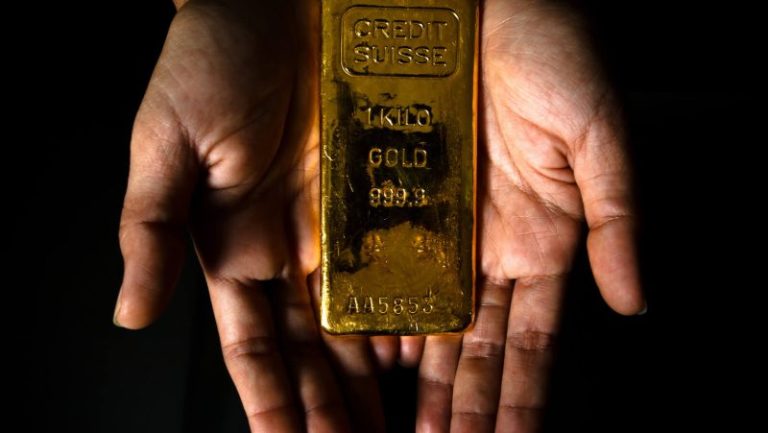Gold has been in the headlines over the last few months, perhaps more so now than in years. This heightened attention stems from shifts in global conditions, including worldwide inflation, escalating geopolitical tensions, a surge in central bank gold purchases, de-dollarization efforts, and the influence of BRICS nations.
If you follow financial media, $3,000 an ounce is the key number, according to analysts from Goldman Sachs, Bank of America, and Citi research, though their timings may vary.
Regardless, the global economy can change a lot over the next few months, especially when the new White House administration takes hold. So, despite analyst projections, keep a close eye on the technical action, as it will likely reflect these changes moving forward.
The weekly chart of gold futures ($GOLD) below gives a wider perspective on gold prices today.
FIGURE 1. WEEKLY CHART OF GOLD FUTURES. Note how gold started going slightly parabolic in March 2024. Is it topping?Chart source: StockCharts.com. For educational purposes.
Gold began its upward trend after hitting a low during the fall of 2022. Throughout most of 2023, the yellow metal remained trapped within a broad trading range. However, in March 2024, gold broke out of this range, gaining significant momentum. This rally culminated in a three-month consolidation pattern, which is where gold is today.
Side note: While this consolidation pattern may resemble a symmetrical triangle to many, it lacks a few key characteristics—especially in terms of volume—so I am reluctant to label it as such.
Gold is generally considered to have a negative correlation with the US Dollar ($USD). As shown in the price overlay, the dollar has been rising since October 2024. Typically, when the dollar strengthens, gold prices decline. However, gold’s reaction to the dollar’s recent advance appears to be relatively subdued so far. So where does that leave us now, with rate-cut uncertainties weighing on market sentiment and inflation data, namely the CPI and PPI, set for release this week?
Shift over to a daily chart comparing $GOLD with the SPDR Gold Shares (GLD), a popular choice for stock investors seeking exposure to gold. I’ll compare both charts since they differ slightly.
FIGURE 2. DAILY CHART OF GOLD FUTURES AND GLD. Note the differences between the ETF and the futures, despite their correlations. Note that $GOLD is EOD, so you are not seeing the current decline at the time of writing.Chart source: StockCharts.com. For educational purposes.
The difference between gold in the futures market and GLD is quite notable. Since futures trade 24 hours a day, price gaps are rare. Additionally, trading volume differs slightly, with the futures market typically attracting larger institutional traders compared to GLD.
If you follow financial news, you may have noticed that many analysts highlight $2,600 as a key support level, suggesting that gold has the potential for further upside. This would be comparable to $238-$240 in GLD. If gold breaks below those levels, the next swing low, one that marks the lowest price point of the consolidation, it would be near $2,544, and for GLD it’s at $236. A break below these levels would invalidate the current uptrend and potentially lead to more downside.
In this scenario, it’s important to reevaluate the broader context—considering technical, fundamental, and geopolitical factors—to gain a clearer understanding of what might be unfolding.
If you’re curious about the momentum and money flow for $GOLD and GLD, you’ll notice a slight difference in their readings. This disparity could provide some actionable insights.
Take a look at a daily chart of gold futures:
FIGURE 3. DAILY CHART OF GOLD FUTURES. Compare this to the GLD chart below, which has the same set of indicators.Chart source: StockCharts.com. For educational purposes.
- The Relative Strength Index (RSI) shows a slight rise in momentum starting at the pattern’s low shown in the previous chart; currently, the RSI is above the 50-line and rising.
- The Accumulation/Distribution Line (ADL) marks the difference between the futures and the ETF. Here, the ADL line has risen above the price whereas it had been moving below it and then unison to it. This paints a picture of bullish accumulation potentially leading price toward a positive breakout.
The daily chart of GLD doesn’t show the same ADL reading.
FIGURE 4. DAILY CHART OF GLD. The ADL reading is declining rather than ascending here.Chart source: StockCharts.com. For educational purposes.
The RSI is the same as the $GOLD chart above, but the ADL in GLD’s chart appears to be descending rather than ascending. This suggests that money flow is decreasing in GLD, while it is increasing in the gold futures market.
Here’s one way to interpret this: If the ADL is rising in the futures but declining in the ETF, it could indicate a divergence in behavior between both markets: institutional and large-scale traders are accumulating positions, signaling confidence in gold, while retail investors are taking profits, less certain about gold’s prospects or more concerned about its risks.
Essentially, this brings up the question: If the institutional traders are the so-called “smart money,” are they going to lead gold higher before the retail crowd jumps in? That’s something to keep in mind as you chart the market.
At the Close
Gold remains a focal point in today’s market, much of it driven by economic and macroeconomic concerns. If gold prices break out above or below its current consolidation range, keep an eye on the key levels. Also, note that institutional actions currently differ from retail sentiment. Is the “smart money” leaning more bullish? That’s something to consider in the days ahead.
Again, the larger economic context is slippery and subject to variants, meaning conditions can change quickly. So, if you want to invest in gold, monitor these changes closely.
Disclaimer: This blog is for educational purposes only and should not be construed as financial advice. The ideas and strategies should never be used without first assessing your own personal and financial situation, or without consulting a financial professional.










